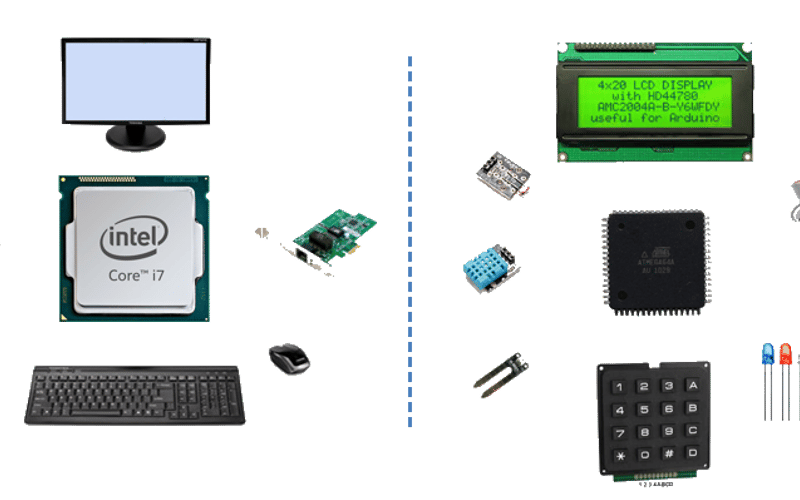Embedded systems and desktop systems, though both integral parts of our modern technological landscape, serve vastly different purposes and operate under distinct principles. This blog post delves into the differences in non-volatile memory usage, overall system design, and the unique advantages of various embedded system architectures.
Non-Volatile Memory Differences
Non-volatile memory in embedded systems, such as Flash memory, is used to store firmware and application code that must be retained even when the system is powered off. This type of memory is essential for embedded systems due to their specific, constrained environments that require reliability and longevity. In contrast, desktop systems use non-volatile memory like hard drives (HDD) or solid-state drives (SSD) to store the operating system, applications, and user data. While both systems use non-volatile memory to retain data without power, embedded systems typically require memory that supports frequent read and write cycles and can operate in a broader range of environmental conditions.
Differences Between Embedded Systems and Desktop Systems
Embedded systems are dedicated to specific tasks with real-time computing constraints and are optimized for low power consumption, efficiency, and reliability. They are commonly found in consumer electronics, automotive applications, and industrial machines. These systems are built to perform their functions without requiring user intervention, often running continuously in the background.
On the other hand, desktop systems are general-purpose computers designed for a wide range of applications, including word processing, internet browsing, gaming, and software development. Desktop systems have more powerful processors, larger memory capacities, and a greater focus on user interface and multimedia capabilities. They support multiple applications and user environments simultaneously, providing versatility and user control that embedded systems do not typically offer.
Advantages of Various Embedded System Architectures
Microcontroller-Based Systems
Microcontroller-based systems integrate the processor, memory, and peripherals into a single chip. This architecture is cost-effective and energy-efficient, making it ideal for simple applications like home appliances, wearable devices, and small-scale automation. The simplicity and compactness of microcontroller-based systems enable them to perform specific tasks reliably with minimal power consumption.
Microcontroller + External Memory
In applications demanding more memory and processing power, a microcontroller is used in conjunction with external memory. This setup expands the system’s capabilities while maintaining the advantages of the microcontroller’s efficiency. Examples include more advanced consumer electronics and industrial control systems where additional memory is needed to handle complex tasks.
Microprocessor-Based Systems
Microprocessor-based systems use a microprocessor as the core processing unit, with external memory, input/output devices, and sometimes a real-time operating system (RTOS). These systems are prevalent in devices like smartphones, tablets, and other portable devices that require significant processing power and flexibility. The external components provide scalability and adaptability to various applications.
System-on-Chip (SoC)
In high-performance applications, complex SoCs combine multiple processors, memory, peripherals, and hardware accelerators on a single chip. This architecture provides high performance for advanced automotive systems, modern gaming consoles, and sophisticated IoT devices. SoCs are designed to handle multiple functions efficiently, offering a balance between power consumption and performance.
Field-Programmable Gate Arrays (FPGAs)
FPGAs offer flexibility and high performance for applications requiring parallel processing, such as signal processing and real-time data analysis. These architectures allow for custom hardware configurations that can be reprogrammed to adapt to new requirements, making them suitable for dynamic applications in telecommunications, defense, and aerospace.
Application-Specific Integrated Circuits (ASICs)
ASICs are designed for specific applications, offering optimized performance, reduced power consumption, and lower unit costs in high-volume production. They are commonly used in consumer electronics and specialized industrial equipment where performance and efficiency are critical. The tailored design of ASICs ensures that they perform their designated functions with maximum efficiency.
Conclusion
Understanding the differences between embedded and desktop systems, particularly in terms of non-volatile memory usage, system design, and the advantages of various architectures, helps in designing and optimizing systems for specific applications. Whether it’s the energy-efficient microcontroller for a simple appliance or a powerful SoC for a complex automotive system, each architecture plays a crucial role in the vast ecosystem of modern technology. As technology continues to advance, staying informed about these systems and their capabilities is essential for making informed decisions in both development and application.
Source link
lol

